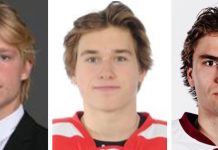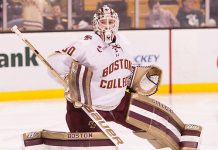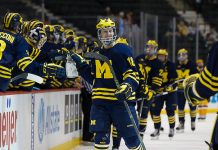Ah, this is the tricky part.
After a season (or, in this case, half a season) of Hobey talk, we’ve reached the point that — to me, at least — defines much of my success as a Hobey blogger. Soon, we’ll know the names of the 10 finalists for this year’s Hobey Baker Award, and this is the point in the season when I take my best guess at who those 10 players will be.
This season, the Hobey blog has focused partly on general questions (i.e. “Elliot’s Rules of the Hobey”) or three specific players: Jack Connolly, Austin Smith and Spencer Abbott. Now, I have to try to pick the top 10, and we’re going to be discussing some players whose names have not appeared in this space all season.
I have an up-and-down history with these predictions over the last five years, including my last full season at CSTV (2007). On two occasions, I’ve correctly named nine of the 10 finalists (2007, 2010). On two other occasions (2009, 2011), I’ve gotten seven. My worst performance was in 2008, when I got six of the 10 finalists. Of the 12 finalists I’ve missed in five years, three have been from the WCHA, three from ECAC Hockey, and two each from Atlantic Hockey, the CCHA and Hockey East. Of the 12 players I’ve predicted incorrectly as Hobey finalists, four were from the CCHA, three were from Hockey East, two each were from ECAC Hockey and the WCHA and one was from Atlantic Hockey. I feel pretty good about these picks, and with any luck there won’t be any missed picks in the bunch. So, let’s see whom we’ve got here …
Spencer Abbott, forward, Maine: See last week’s blog post. Nation’s leading scorer, Maine team likely to return to the NCAA tournament for the first time since 2007. I shouldn’t need to draw you a picture here, folks.
Jack Connolly, forward, Minnesota-Duluth: Again, another obvious one whom we’ve discussed in depth this season. He’s captain of a team that has had very little of the expected drop-off from last season’s NCAA title run despite the departure of his former linemates, Justin Fontaine and Mike Connolly. Yes, a lot of his points come on the power play, where he plays with J.T. Brown and Travis Oleksuk, but I’ve never really bought into the idea of power play performance counting against a Hobey candidate. The team doesn’t need the scoring any less when there’s a man advantage.
Austin Smith, forward, Colgate: The goal count is now at 36 in 37 games. One way or another, he’ll have two games this weekend in Atlantic City to get to 40, although that he’s slotted in for one game against his conference’s best goaltender (see below) could prove detrimental to his cause. My gut feeling about Smith remains the same as it did the last time I discussed him: Forty goals and a Whitelaw Cup as ECAC Hockey playoff champion gets him into the Hat Trick with a shot at the Hobey; one or the other, and he’s got a chance at the Hat Trick; neither makes him a long shot. At the moment, though, we’re talking the top 10, and Smith is a lock.
Reilly Smith, forward, Miami: No relation to Colgate’s Smith, but he is the brother of a former Hobey finalist, 2010 finalist Brendan Smith of Wisconsin. I was convinced in January of that year that Brendan Smith was going to win the Hobey, but wound up having the wrong Badgers player when Blake Geoffrion won it. Obviously, Smith is more like Geoffrion as a player than he is like his brother, by virtue of position (duh) and his propensity for scoring big goals. He leads the nation in game-winning goals with eight, and he’s a key cog for a Miami team that appears to be locked into an NCAA tournament berth.
Justin Schultz, defenseman, Wisconsin: If the Badgers had pulled off the upset last weekend in Denver, I would be giving serious consideration to Schultz for a spot in the Hobey Hat Trick, and the truth is that he might still make it yet. After all, an NCAA tournament appearance is not prerequisite for a spot in the Hobey Hat Trick. Just ask Chris Higgins and Gustav Nyquist, among others. Personally, I think the triumverate of Abbott, Connolly and Smith is going to be very hard to crack, especially with Schultz done for the year, but he’s been an outstanding performer for the Badgers this year, and is the nation’s top scoring defenseman.
Nick Bjugstad, forward, Minnesota: Bjugstad is fourth in the nation in goals per game, but to be honest, I don’t feel as great about this pick as some of the others on here. I think he’s benefitted from early buzz and continues to benefit from the fact that Minnesota is on track for a return to the NCAA tournament, where it has been conspicuous by its absence in recent years. On the other hand, this tends to be an older player’s award, and Bjugstad is a sophomore. I wouldn’t be too stunned if he was on the outside looking in when the Top 10 are announced, but for now, he’s on my list.
Shawn Hunwick, goaltender, Michigan: The Wolverines senior netminder is the only goalie in the national top 10 in save percentage or goals against average to stop more than 1,000 shots this season, starring for a Michigan team that’s on track for a top regional seed in the NCAA tournament and heads to this week’s CCHA Championship as the favorite to win the Mason Cup. Not too bad for a guy who was supposed to be a Division III player once upon a time. He’s fourth nationally in save percentage and seventh in goals against average, and I like him to be in the Hobey top 10.
Troy Grosenick, goaltender, Union: I am perennially guilty of lowballing Union when I fill out my preseason ECAC Hockey ballot, but it was hard to blame anyone for predicting a rough year for Union after coach Nate Leaman left for Providence and Keith Kinkaid turned pro. Grosenick stepped in and backstopped the Dutchmen to their second consecutive Cleary Cup, posting the third-best save percentage and goals against average in the country. Union is on track for a No. 2 regional seed, and Grosenick has to be looked at as the biggest reason.
Drew Shore, forward, Denver: I was tempted to put Colorado College forward Jaden Schwartz in this spot, and if the Tigers had won their series with Michigan Tech, the decision would have been harder to make. As it is, though, the Pioneers are going on to the Final Five, and Schwartz is no longer a college hockey player, having signed on Monday with the St. Louis Blues. Shore is one of the nation’s top 10 scorers for a Denver team that is on track for an NCAA tournament berth. It’s not my most confident pick, but I think Shore is in this group.
Brian Dumoulin, defenseman, Boston College: This was the hardest spot for me to pick, honestly, and it’s a bit of an “under the radar” pick, since Dumoulin doesn’t exactly have eye-popping numbers (six goals, 20 assists, 25th in defenseman scoring). Here’s my thinking: At this point, there are four players on the list from the WCHA, two each from the CCHA and ECAC Hockey, and one from Hockey East. I think it’s most likely that the last spot goes to a Hockey East player, and with BC riding high as the No. 1 team in the nation (polls and PairWise Rankings), it’s a good bet that an Eagles player goes into the spot. Dumoulin has been exceptionally steady for BC this year, leading the team in plus/minus at plus-20, and since no Eagles forward has eye-popping numbers this year, Dumoulin strikes me as the guy. There’s a precedent for a stalwart two-way defenseman without big-time numbers in the mix; St. Lawrence defenseman Drew Bagnall was 33rd nationally in defenseman scoring in 2006-07, when he was honored as one of the top 10 Hobey finalists. I think that’s partly a function of the coaches doing this round of voting, since they sometimes see things that aren’t as apparent to us “ink-stained wretches” (not that we use all that much ink any more). I like the coaches to put Dumoulin in the top 10.
So, that’s my top 10 for now. Check back when the official top 10 is released, and we’ll see where I went wrong and where I went right.


